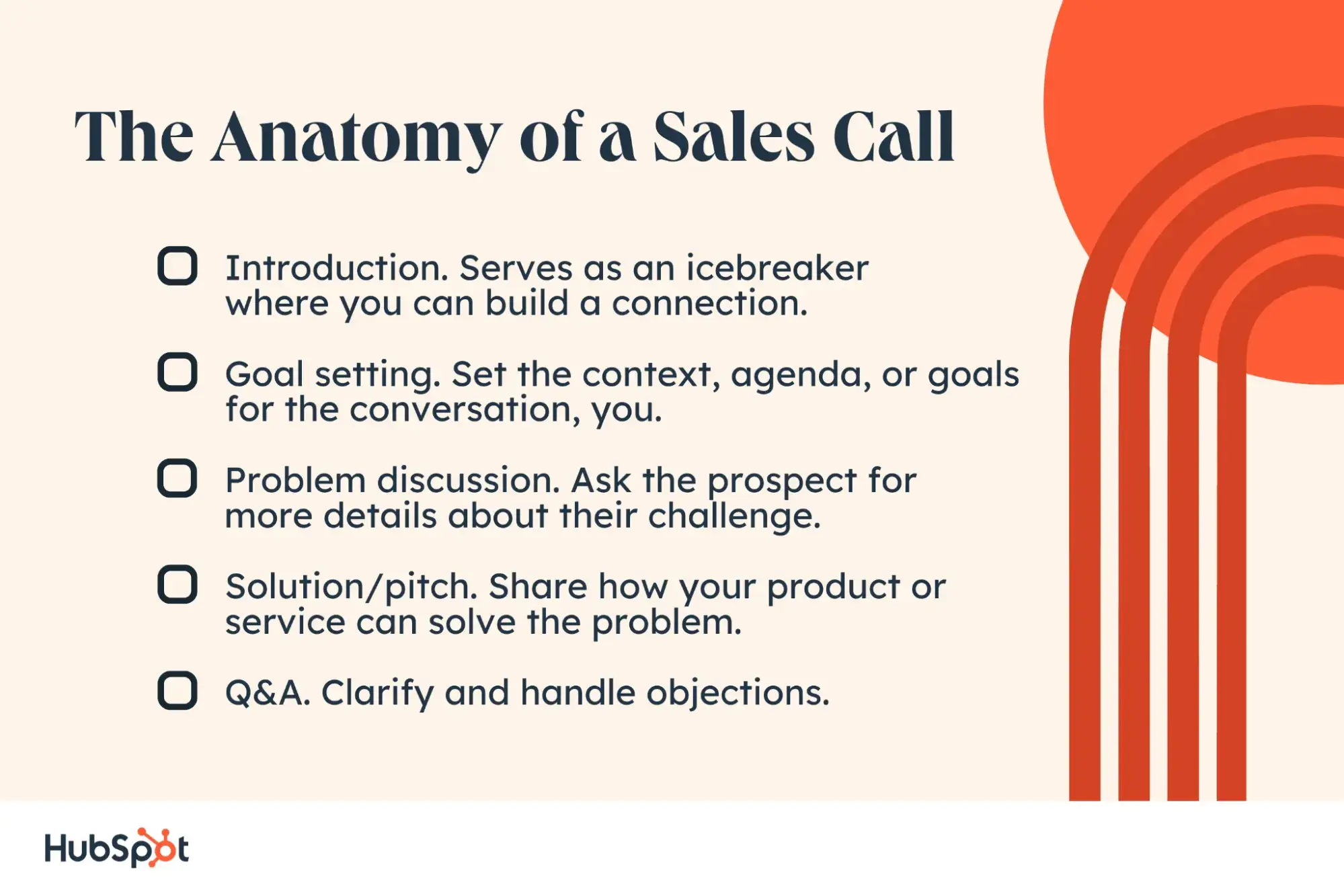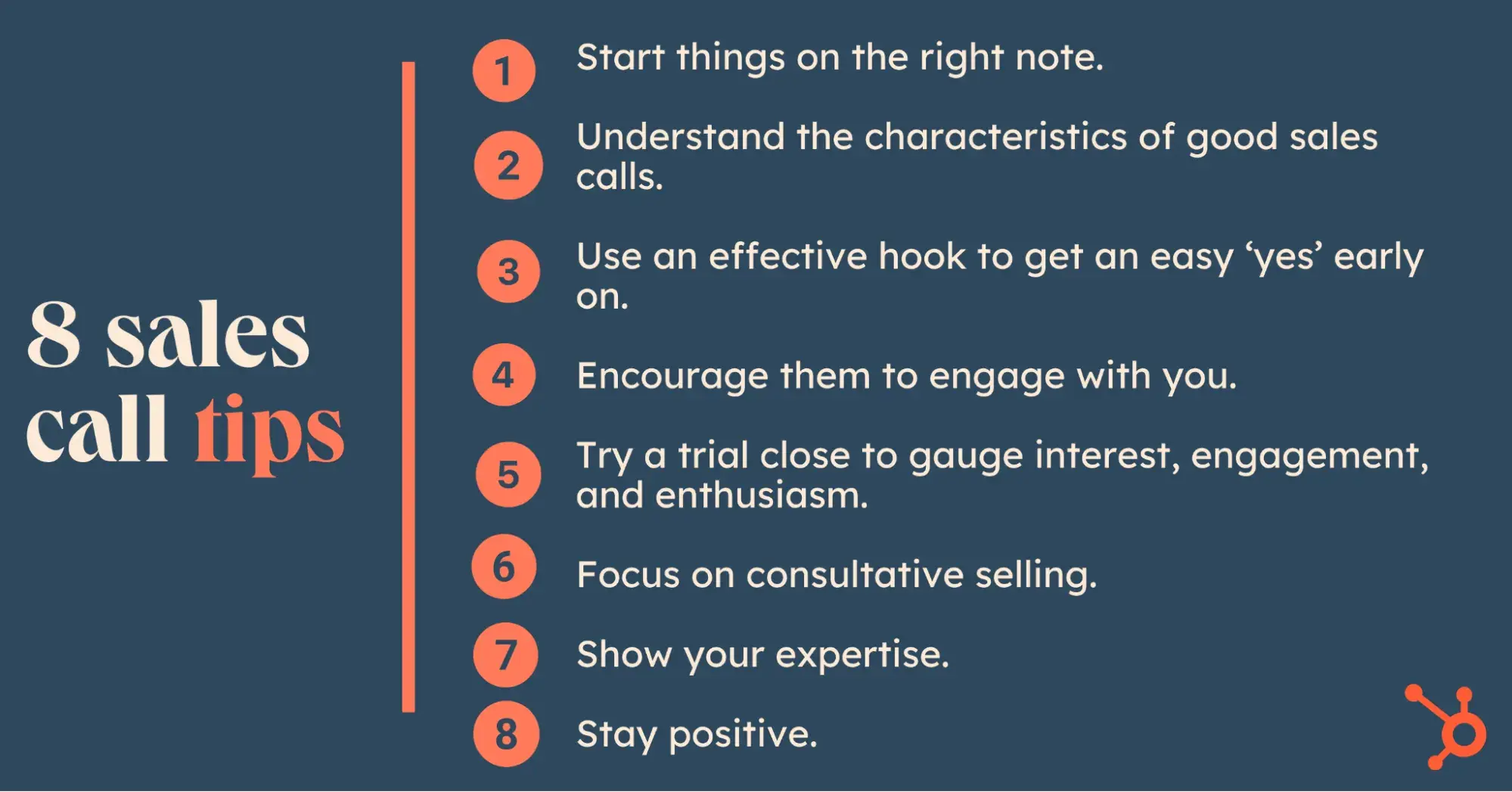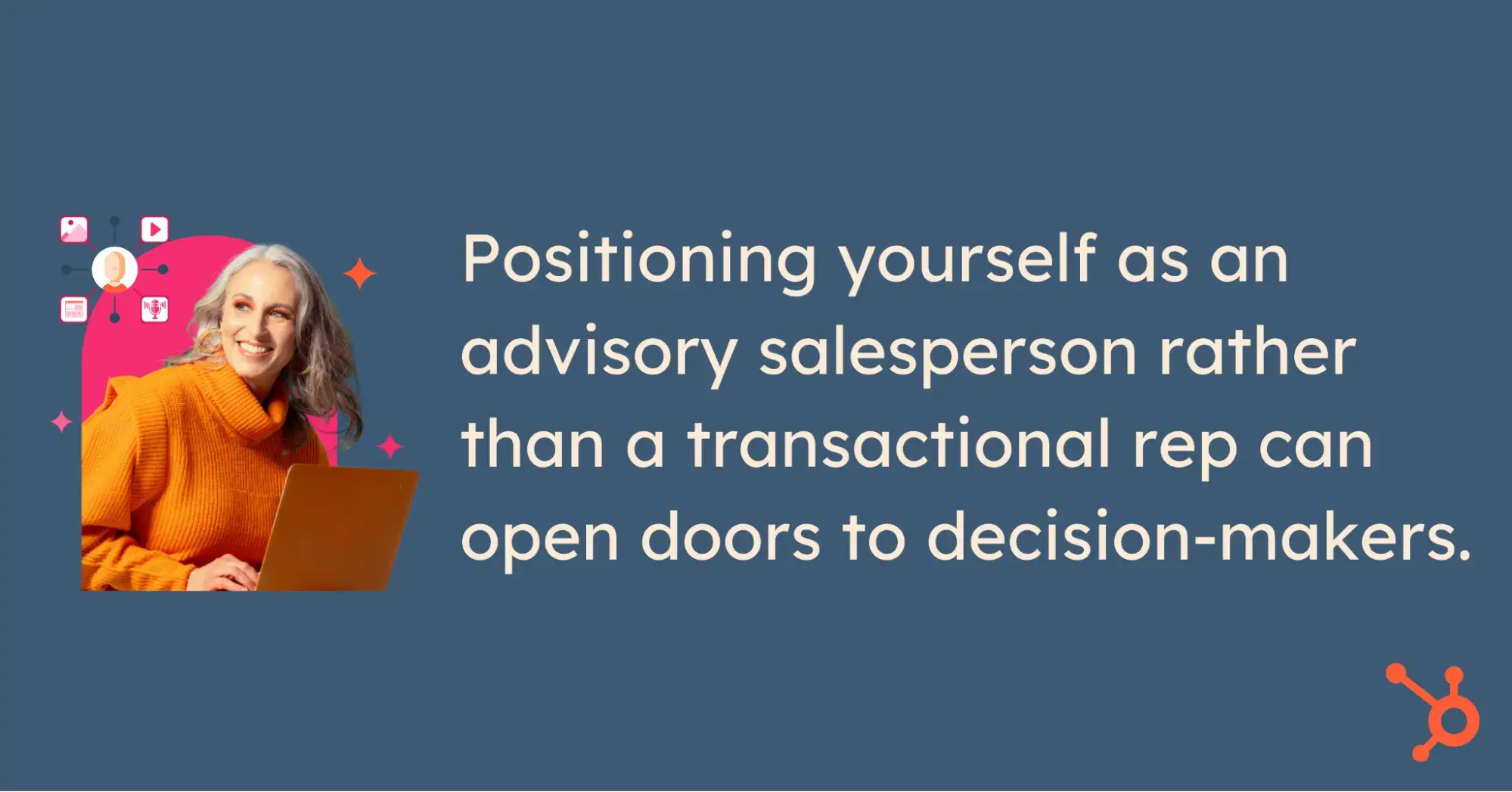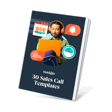The odds aren’t in a sales rep’s favor in the digital age. In fact, according to HubSpot’s Sales Trends Report report:
- Most prospects (96%) research companies and products before engaging with a sales representative.
- Only 37% of sales representatives produce the most leads from phone calls with cold outreach.
There are many opinions on how to starts a sales call and make the best use of your “moment of truth” — the first eighteen seconds or so. Well, here are my thoughts on how to start a sales call based on years of experience. You’ll also find great insights from other sales and marketing pros.
Table of Contents
- Why is a sales call opening important?
- 7 Tips to Prepare for Sales Calls
- 8 Sales Call Tips
- What is a sales call?
- How to Prepare for a Sales Call
- Make Your Next Sales Call a Success
Why is a sales call opening important?
The sales call opening is the gateway to the rest of the conversation. By learning to open a sales call in a way that intrigues the prospect and gets them to listen further, you're maximizing your chances for a productive sales conversation.
What is a sales call?
First, let’s get aligned on a simple sales call definition.
Sales calls are conversations between a seller and a customer or prospect. They may be face-to-face interactions, or discussions over digital channels like social media, email, live chat, phone calls, or video meetings.
Successful phone and video interactions remain very popular and effective, and they have similar characteristics. According to a recent HubSpot survey, 75% of sales professionals say they use phone calls for remote selling, with 40% saying they use video.
Rookie sales reps and veteran telesales people resist video calls, but they really have to get over being camera shy.
Video sales calls:
- Enable salespeople to pick up on body language clues that phone calls don’t convey, like posture or facial expressions.
- Establish a more personal connection compared to emails or phone calls.
- Are more effective at building rapport and trust.
- Help sellers to better control conversations by listening for clues on when to stay on a topic a prospect seems engaged in or when to pivot to something they care more about.
I’ve recorded video pitches and embedded them in emails as a way to make a personal connection to get buy-in for a video meeting. My favorite application for this is Vidyard.
Understanding warm vs. cold leads
Cold leads, or prospects, are people who haven’t indicated an interest in a product or service. Sales professionals find them through a variety of methods, including but not limited to phone listings, social media, event attendees, and other online resources. Most cold calls take place over the phone, email, or social media.
I made my cold call goal simple: to secure discovery meetings on my first call. I also found that if a prospect heard my voice or saw my face on a video call, it took the pressure off the crucial start of the call.
In contrast to cold leads, warm leads have already indicated an interest in your product or service. Sometimes, a warm lead takes the initiative and reaches out themself. Sometimes, the seller has contacted them first and “warmed them up.” But because they’re already receptive, these conversations can take place over the phone or video and often require less persuasion.
How to Prepare for a Sales Call
Benjamin Franklin isn’t famous for his sales prowess, but his adage, “By failing to prepare, you are preparing to fail” rings true when it comes to mastering the art of sales call openers.
The most successful sales professionals know that a sales process begins before they even dial a prospect’s phone number. Whether you’re cold calling or working with a warm lead, the key to success lies in preparation, so that a sales call instills confidence and trust right from the outset.
Today’s sales reps have access to more prospect information than ever, thanks to AI, social media, and CRM applications. Knowing how to prioritize and gather the intel you need to convince a customer and build a business case for your products and services is critical.
Sounding nervous or uncertain in a sales call opening pitch can make your prospect wonder whether your company can, in fact, help their business how you describe. An effective cold call script can help you come across more professionally when it’s written conversationally, and you can use it more for support than to read word-for-word.
Many sales people resist using cold call scripts because they think it feels unnatural. My most successful sales calls usually occurred when I had discovered a reason for calling the prospect through research in the news — as opposed to using a “spray and pray” approach.
I remember one sales training course I took where the coach insisted my team write a sales script that didn’t include my company’s name. We were only allowed to describe the business problems my company could help the prospect solve. I tried using the script a few times. The trainer insisted the method worked, but it felt as unnatural to me as it did to the prospects that I spoke to. So, when you’re using a sales script, be sure to tailor it to your style, the conversation at hand, and to be responsive to the prospect on the other end of the line.
7 Tips to Prepare for Sales Calls
- Research your prospect, their company, and their industry.
- Identify key decision-makers.
- Prepare a competitive analysis.
- Outline the most likely pain points.
- Outline the benefits of your product or service.
- Identify their likely objections.
- Build custom presentations for each prospect.
1. Research your prospect, their company, and their industry.
I quoted a celebrated American statesman, inventor, and political philosopher above, so I’ll quote a famous economist for my next point. W. Edwards Deming once said that, “Without data, you’re just another person with an opinion.”
When you do your research on a prospect and their business, find some meaningful data points that will convince a prospect to invest their time with you for a sales call. Publicly traded companies are easiest to research about topics like business growth, productivity, supply chain efficiency, or security breaches.
Make sure you have at least a high-level understanding of your prospect and their company. You don’t need to know the name of their childhood pet, but you should have an understanding of the problems businesses in the prospect’s industry face, and how their company is performing relative to their closest competitors. These data points will help you position your products and services in terms of the real challenges they are facing.
Additionally, going into a sales call with data about your prospect not only proves that you value the prospect’s time, but that you took the time to understand the obstacles that stand in the way of meeting their business goals.
Asking what keeps a prospect up at night and giving an uneducated opinion of how buying from you would help them sleep better doesn’t earn you a seat at their table. Doing some research and defining how your company’s offerings can add value to their business does.
2. Identify key decision-makers.
Ideally, your prospect is the key decision-maker, but there are many times when they’re the first call or your foot in the door. If they’re not a key decision-maker, you can explore the challenges they face and how solving them would make them look good to leadership.
At IBM, we called the process of discovering the needs of different tiers in a corporate hierarchy “addressing the pain chain.” For example, a sales director may have challenges with their reps’ forecast accuracy. The VP of Sales will share in that pain, so if your solution can solve their problem, the sales director can be your champion in getting access to the ultimate decision-maker, and thus move the opportunity forward.
Connecting with employees who influence a sales decision is an important step in the sales process. It is often easier to access an influencer who can then help you gain access to the decision-maker than trying to go direct.
I developed relationships with influencers who gave me valuable information on how to navigate their business and what they needed to build a business case for my solution.
3. Prepare a competitive analysis.
A recent HubSpot study showed that standing out from the competition is one of the biggest challenges sales professionals face. In order to stay competitive, it’s important to know what your competitors are doing and how your product or service stacks up.
Consider preparing case studies, testimonials from clients who have switched, or even direct comparisons.
4. Outline the most likely pain points.
By taking the time to outline their likely pain points, you’ll be better able to speak to their needs during the call. While surprises do happen, by preparing up front, you’ll minimize the likelihood of having to change gears or think on your feet during the conversation.
You can use the pain funnel from the Sandler Sales System to uncover:
- Who in an organization is feeling pain.
- The severity of that pain.
- The ramifications if the company addresses the pain versus if they don’t.
- How your company’s products and services can address that pain.
I used to work with an Open Text executive named Cheryl McKinnon (now a Forrester analyst) who recommended that salespeople categorize their products or services as candy or aspirin.
Solutions that they need to relieve pain can be positioned like aspirin. The products and services they want to buy to increase profitability and growth, etc. are like candy.
I’ve often thought about this comparison throughout my sales and marketing career.
5. Outline the benefits of your product or service.
If you’ve been through any sales training in the past, you’ve likely heard people talking about features versus benefits. While it sounds impressive to say that your product or service has a specific feature, make sure you have a list of why each feature is important.
You can probably come up with a list of at least two to three benefits for each feature, allowing you to speak to your prospects’ concerns quickly and effectively.
6. Identify their likely objections.
Overcoming objections is one of the most important skills of any salesperson. Most objections fall into one of four categories: budget, trust, need, and urgency. However, the specifics depend entirely on your product or service and their business.
By creating a list of your prospect’s most likely objections specific to their company and your product, you can help them understand why buying from you is a good decision.
7. Build custom presentations for each prospect.
Research shows that 80% of U.S. consumers are more likely to purchase if you personalize your efforts. Even if your pitch is almost identical from client to client, build a presentation that uses their name and company logo where applicable so it feels personalized.
Whether you’re presenting to your prospect on a video call or simply discussing their needs over the phone, demonstrate that you have a vested interest in helping them solve their pain. Demonstrating and having put thought into the sales process builds trust. Discuss conversations you’ve had with multiple stakeholders. If you’ve put in the work, get recognized for it!
8 Sales Call Tips
- Start things on the right note.
- Understand the characteristics of good sales calls.
- Use an effective hook to get an easy ‘yes’ early on.
- Encourage them to engage with you.
- Try a trial close to gauge interest, engagement, and enthusiasm.
- Focus on consultative selling.
- Show your expertise.
- Stay positive.
Let’s say you’ve done your homework, and you are thoroughly prepared to impress a prospect on a scheduled phone conversation, or video conference. It’s your time to shine, and show off your consultative selling skills.
Here are 8 tips to make the most of every sales call.
1. Start things on the right note.
Kick things off with a warm, friendly, and professional tone. Open the sales call by:
- Engaging the prospect with an intriguing idea or thought-provoking question.
- Get the prospect into a receptive frame of mind.
- Encourage engagement throughout the call (because engagement reduces the likelihood of them stopping the conversation). Stop occasionally to check whether you are on the right track.
- Make it easy for them to make a positive decision with questions that are easy to say “yes” to.
2. Understand the characteristics of good sales calls.
The structure of sales conversations varies by a prospect’s industry and the role the person you are talking to plays in the decision-making process. However, most sales calls — especially the most effective ones — follow a similar pattern:
- Introduction. Often casual, this usually serves as an icebreaker where you can build a connection.
- Goal setting. After the initial few minutes, it’s time to transition to the business side of the call. By setting the context, agenda, or goals for the conversation, it demonstrates that you are prepared for the call. Asking the prospect if your agenda aligns with their expectations, or if there are any items that they’d like to add can help you course-correct early instead of going off on a tangent and wasting valuable time.
- Discussing business challenges and opportunities. The salesperson might share research about the company and then ask the prospect for more details about their challenge.
- Solution/pitch. In this phase, the salesperson shares how their product or service can solve the problem, with a high-level overview of the potential outcomes.
- Q&A. The focus here is on clarifying and handling objections.
- Next steps. Think of this as the call wrap-up, where the buyer and seller agree to next steps, which might include sending over a formal agreement, scheduling the next conversation, or moving on to the next phase of the sales process.
When you understand this structure, you can more effectively navigate your sales presentations and transition from section to section.

3. Use an effective hook to get an easy “yes” early on.
After your opening, one way to get people in the right frame of mind is to ask a yes/no question related to what your product or service can help them do.
“Wouldn’t it be great if your CRM could help you enrich your customer and prospect intelligence?”
When you get buy-in to your value proposition upfront, it puts them into a more positive frame of mind. They will be more receptive to your proposal to do business. If they don’t answer positively at this stage, it will be easier to handle objections now and keep the sales process moving forward. Failing to address concerns now can create a problem down the line.
4. Encourage them to engage with you.
Keep in mind that while you’re shooting for a sale, your goal on the call should be to keep your buyer engaged — successful calls have “77% more speaker switches per minute.”
“I’ve done some digging ahead of time, but I don’t want to tell you what I think your problem is. I want to listen to you to learn more about what’s going on with your business. I may stop you and ask some questions to get more information.”
Or something like this:
“Based on what you shared, I think I can help. Before I go into more detail though, feel free to ask questions as I go.”
Giving them explicit permission to talk early on helps them.
5. Try a trial close to gauge interest, engagement, and enthusiasm.
Sometimes, the best thing you can do is abandon the traditional selling playbook (because people get used to those) and get a feel for where the prospect is in their decision-making process. It can help to motivate the prospect to state their objections and discuss any obstacles.
There are three types of trial close techniques:
- The assumptive close. You observe buying signals, and you confirm with the customer if you meet their stated needs, and if you can move forward to a transaction.
- The alternative close. You offer a couple of options for the customer to buy, such as SaaS subscription tiers.
- The summary close. You recap how your company or your products and services can help the prospect to meet their needs, and then you ask whether based on that agreement they would be willing to buy.
Trial closes are a little like playing chicken, but they can be used at the end of every conversation. It helps sellers to move the sales process forward after every sales call by confirming they are meeting expectations, that objections are addressed, and that you are aligned on what will be addressed during the next sales call.
6. Focus on consultative selling.
The best salespeople strive to differentiate themselves as strategic advisors. Consultative selling is about adding customer value. I found this approach helps in competitive sales engagements and can shift sales conversations from features and costs to strategic value and return on investment.
How do you do this on a sales call? By practicing active listening, confirming you are paying attention, and clarifying any misunderstanding.
“What I’m hearing you say is _____, is that right?”
Sure, your goal right now is to get the first sale. But it’s also the first step in building a relationship that lasts. It’s easier to sell to existing customers than to new customers. 60-70% of customers will buy from a company they’ve purchased from before, because they are familiar with the buying experience and the quality of your products and services. Not only that, if you provide exceptional service and a positive experience, they’re likely to spend 140% more with you.
7. Show your expertise.
Speaking of your prospect's competitors, they likely experience some of the same issues that your prospect does. Your prospect is likely aware, and solving these problems can give them a competitive edge, especially if you can show them some proof.
“We’ve been working with a couple of similarly sized companies within your industry, and they are experiencing two major problems. I wondered whether they were causing you concern as well…”
This shows that you understand their industry and company, and if they didn’t have these concerns before, it also demonstrates that you’re looking out for their needs.
Want to level up your sales game with interactive playbooks that provide the best practices for sales plays, scripts, guides, and more? Get a demo of HubSpot’s Sales Playbook Software to see how it can help you close more deals.
8. Stay positive.
When you believe you can or will succeed, you’re more likely to take the steps that will help you do so. With that in mind, mindset is one of the most important factors in your success.
Our recent data supports this as well, with sales professionals ranking willingness, empathy, and adaptability as the most important traits for effective sales leaders.
While you certainly want to go into each call with an optimistic mindset, it’s also important to prioritize maintaining that sense of positivity throughout your day — and career.

A good opening is critical for successful sales calls. Here's how to start the sales call with openers that engage the prospect so they don’t immediately hang up.
1. Greet the customer or prospect warmly.
Many prospects regard sales calls as distractions, and tune out any call they weren’t expecting. However, if your greeting is warm enough (like an old friend), you may get them to pause long enough to consider what you’re saying. You might open with:
“Hello [Name], how have you been?”
Opening with their name acknowledges the prospect. We're hard-wired to respond to the sound of our name, and this greeting creates a sense of familiarity and respect.
“How have you been?” is superior to “How are you?” because it acts as a pattern-interrupt. The prospect often finds themselves considering if they've met you before, and this may give you an opening to continue the conversation. What’s more, salespeople who ask this question have a 660% higher success rate.
Some prospects view such a warm greeting as misdirection, so do your best to get to the point after the greeting.
2. Mention the research you've done about their company.
Prospects on the other end of your call are less likely to stop you in your tracks when you personalize your approach by showing you have done your due diligence on their business. Try opening up the conversation with something like this:
“My research shows that your company is in the process of...”
This demonstrates sincere interest and you’ve spent some time finding a reason for calling. It also shows you aren’t trying to sell them something right away.

3. Drop the name of a mutual connection.
Discussing a mutual connection gives you instant credibility. If you've spoken to someone you have in common with the prospect, consider something along the lines of:
“One of my clients, [Name] at [Company], mentioned to me you are [looking for, might be a good fit for]...”
Your prospect will be curious to know why her contact thought she might need your product or service. Across all industries, people have former colleagues, peers, and partners that they keep in contact with. Make sure to ask for permission to mention their names in conversation.
4. Reference a company contact.
Even better than a mutual connection would be a coworker of theirs who you've had contact with.
“[Prospect], I was speaking to one of your business managers yesterday, and he said that a growing part of your business is through [product, niche, market]. As that’s the case, I can…”
Bringing up your prospect’s coworker tells them to take you seriously, while focusing the discussion on an emerging revenue source ensures you’re talking about a company priority.
5. Use information from their LinkedIn profile.
Speaking of research, you can find valuable things to bring up from a prospect's LinkedIn:
“I was looking at your LinkedIn company profile and saw that one of your major projects this year is...”
Referencing their LinkedIn page and company goals proves you’re interested in discussing something of value to them rather than just pushing your products and services. Keep in mind that it's important to have a plan for how to lead into the sales conversation from there.
6. Avoid referencing your relationships with competitors.
It’s important to pose your introduction as a question; your tone of voice should imply they’ve heard of you and your company before. Be cautious with this tactic. Describing the results from competitive relationships can be a deterrent in some cases. Your competitive relationship may backfire for several reasons:
- Confidentiality risks or conflicts of interest - Can you, or will you be equally loyal to both companies? Could you disclose company secrets, even accidentally?
- Eroding trust - Companies don’t like to reinvent the wheel, but the fact that you are sharing information about a competitor’s competitive gains may encourage them to check out your competitors. Case studies are great selling assets, but they are usually thoroughly approved by the companies that are featured in them.
- Perceived pressure and alienation: If you have an existing relationship with a prospect’s competitor, will your loyalties be influenced by the company that spends the most money with you? Has the prospect’s competitor acted unethically? By extension, does your business conduct business unethically?
Sometimes, a competitive relationship can end a sales call prematurely. If you want to reference a similar company in a prospect’s industry, try and find a company that doesn’t compete with them head-to-head. If the prospect finds out you work with their competitor, assure them that you provide personalized service to your customers, and maintain strict privacy boundaries. If your business already works with competing businesses, explain how you keep each company’s business matters confidential.
7. Don't be afraid to engage in small talk.
Small talk is one way to humanize yourself and build rapport, but it only comes across as authentic if you've done your research. Casually mention something in common, such as:
“I noticed you're from Tucson. I actually met my wife at the University of Arizona.”
If they are familiar with the university — or, even better, if they also attended the university — you can continue the conversation from there.
Remember to respect your prospect's time as much as possible, though. Too much meandering will leave them wondering the purpose of the call.

8. Reference topics brought up on their social or marketing channels.
Reading their marketing materials reveals genuine interest in their company. It also implies your recommendations will be pertinent and helpful. You might open with one of these:
“I read your [Twitter, Facebook] post the other day about...”
This opening tells the buyer you’ve done your homework and are calling about a relevant and timely topic.
“[Name], in reading your company blog, I noticed that you’ve had some good reviews from customers on your new [product], and I was wondering...”
Your interest in their blog can open new doors to discuss results that your products have achieved for other clients.
“I see your [annual report, newsletter] was released on your website last week, and it’s looking like you’re expanding your operations in...”
The company likely puts a lot of effort into the annual report, so discussing the topic can create opportunities as you listen for pain points and triggering events.
9. Ask for help or a favor.
You might have become a salesperson because you like to help people solve problems.
Try opening a sales call asking for help, such as help finding the person who would oversee the problems that your products and services address and related purchasing decisions. It’s human nature to be motivated to respond to a request for help if it’s within reason.
Hopefully the prospect will be compelled to do their good deed of the day and help you access the decision maker — or help you by investing the time you need for a discovery call.
I often found being vulnerable and asking for a favor triggered a prospect’s sense of empathy and they dropped their defenses.
10. Ask for permission to speak now or later.
Sales is an honorable profession, and you should be proud to be in it.
If a prospect answers the phone, make the goal of the conversation to get permission to discuss their business now, or at a convenient time for all.
Be frank and unapologetic about your role, but demonstrate you have done your research, and be sure you have some valuable insights that will make your conversation valuable to both of you.
11. Have something of value to offer.
Offering something of value in return for a prospect's time can significantly increase engagement. This could be access to a webinar, an industry report, competitive insights, or a personalized solution that addresses the needs of companies in their industry.
By demonstrating immediate value, you not only capture their attention, but also build trust and set the stage for a more productive conversation.
I once discovered a prospect’s website had offensive content added to it by a disgruntled web designer. The prospect was very grateful I brought the matter to their attention, and I ended up building a great working relationship with their VP of sales.
12. Mention common relationships.
Earlier in this article, I mentioned the value of speaking to multiple people in an organization (or with people from organizations they partner with) to gather insights before approaching a decision maker. Sometimes, I found it helpful to become a member of industry associations, user groups, and other communities as a way to warm up cold calls.
I often found when I had multiple mini-discovery calls in an organization, it helped to gather perspectives about the challenges a company was facing, or the goals they were pursuing. I could then approach the decision-maker with an informed and compelling business case for a discovery call. Of course, I would always ask the people I spoke to for permission to reference our call when speaking to decision-makers.
13. Differentiate yourself as a strategic advisor, not a transactional sales rep.
Positioning yourself as an advisory salesperson rather than a transactional rep can open doors to decision-makers by emphasizing your role as a trusted consultant.
By focusing on understanding their challenges and having personalized conversations, you demonstrate a genuine interest in their success. It can build credibility and foster long-term relationships, making decision-makers more likely to engage with you.
Pro tip: Using tools like HubSpot Breeze to enrich your company’s market intelligence can give you a competitive edge over companies using time-worn sales tactics. AI-powered prospecting agents can accelerate outreach to earn access to decision-makers.

14. Don’t be cringe-worthy.
Do you ever get LinkedIn invitations without introductions, and you know there will be a sales pitch if you dare accept the connection?
Sales calls that open with cringe-worthy, cliche opening lines make prospects experience that same feeling of dread.
Open your sales call confidently, and make it clear what the prospect stands to gain by investing their time with you.
Position your discovery call as an opportunity to determine whether the prospect’s business has needs that align with your company’s capabilities. Assure the prospect that after the discovery call, they won’t be locked into a sequence of endless follow-ups if they aren’t convinced there is value in it.
This approach can differentiate your sales reps from others and build a solid foundation for a professional relationship.
15. Build reciprocal business relationships.
I was a member of a B2B referral-based network for a few years while I was in sales. If I ran across a need for the products or services that other members of the community could address, I would introduce them to the prospect.
I also worked for several years for technology companies that offered complementary products through an independent software vendor channel. I found that when I sent business leads to my ISV partners, they would often return the favor when they discovered needs within their client and prospect interactions.
As mentioned above, your existing relationships can open many doors, if you’re willing to explore them. Name-dropping a common connection in a sales call opening can ease the uncertainty of your call and build trust.
Make Your Next Sales Call a Success
I hope this guide provides you with the insights you need to open sales calls that build prospects’ credibility and trust in you, your company, and its products and services.
Getting through to decision-makers and capturing their attention and interest is becoming increasingly difficult. Nowadays, you only have about 20 seconds to navigate past a prospect’s instinctive inclination to avoid sales pitches that can disrupt their regularly scheduled business day.
Open sales calls by expressing interest in helping prospects solve business problems. Close sales calls by instilling confidence that you can help them solve those business problems.
Give the prospect a reason to, at the very least, discuss options with you, making it likely the call will end the way you’d like — with a discovery call.
Editor's note: This post was originally published in January 2018 and has been updated for comprehensiveness.
Sales Calls












